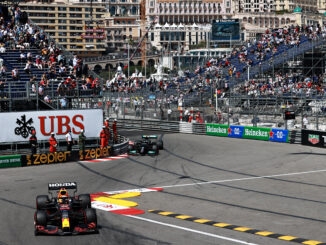
It’s just two races into the 2018 Formula 1 season and already we’ve seen four unsafe releases in the pitlane – two from Haas in Australia and two by Ferrari at Bahrain.
Ferrari’s second pitlane mistake of the weekend at the Bahrain Grand Prix left mechanic Francesco Cigarini needing surgery to repair a double leg fracture after he was run over by Kimi Raikkonen leaving the pit box before the crew finished changing the Finn’s tyres.
In the four cases that’ve happened so far this year, the cars have gone to rejoin the track because the automatic traffic light systems used by teams instead of a lollypop man told the driver to go. However, the mechanics instantly knew in each case that the car wasn’t ready. Is it time for a rethink over the reliance on automatic systems during the pitstops? What can be done to prevent a similar accident happening in the future?
The Raikkonen incident in Sunday’s race in particular has resulted in some to call for the automatic release systems to be abolished in favour of the lollypop man, who can wait for a definite signal from each wheel gun mechanic to ensure the car is ready to return to the circuit. Had a person been stood at the front of the Ferrari watching the tyre change, they would have noticed the crew on the left rear struggle to get the used soft off, and that Cigarini was still stood in front of the tyre waiting to put the new supersoft on.
Ferrari were one of the first teams to introduce the traffic light system, but errors during the 2008 season resulted in the system being abandoned for the final three races of the calendar. The automatic system released Felipe Massa into the path of Adrian Sutil at the European Grand Prix, while Raikkonen and Massa were both involved in incidents where they drove off with the refuelling hose still attached. The problems with the refuelling hose resulted in refuelling being banned from 2010 onwards.
Traffic lights have helped pit crews reach a stage where anything over 3 seconds is considered slow for a tyre change. As fractions of a second can prove vital, particularly during the pitstop, a mechanic with a lollypop could still be fallible, trying to get the car back in the race a tenth or two quicker than the team in the next garage.
Other suggestions touted by F1 pundits and fans include a two-second delay between the end of the tyres being fitted and the light turning green, giving the pit crew time to signal if there are any problems before the car leaves, having fewer people allowed to work on the car to slow the pitstops down and an extra person spotting for signals from the mechanics. With both Raikkonen incidents at Bahrain and the two Haas unsafe releases in Australia, the team on the tyre that wasn’t fitted correctly gestured for the car to stop, but as the crew were behind the drivers they couldn’t see, meaning they had to wait for a message on the radio to tell them something was wrong. A radio on one of the mechanics would also allow them to tell the driver more quickly if there was a problem.
Unsafe releases are nothing new, but the injury to Cigarini and the number that have happened so far this season could force F1 bosses to have a rethink and bring in changes to the pitstop regulations for 2019. Haas admitted they didn’t practice their pitstops enough ahead of the Australian Grand Prix because they had other issues throughout practice, so designated pitstop practice periods could be considered, as well as changes to the automatic release procedure and the personnel needed for a pitstop. Although the injury to Cigarini looked horrific, he has undergone successful surgery in Bahrain and has since posted a video of himself using crutches on Instagram.




Leave a Reply
You must be logged in to post a comment.